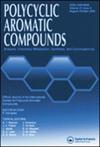Synthesis of Isatin-Schiff Base and 1,2,3-Triazole Hybrids as Anti-SARS-CoV-2 Agents: DFT, Molecular Docking, and ADMET Studies
IF 2.6
3区 化学
Q2 CHEMISTRY, ORGANIC
引用次数: 0
Abstract
This study focuses on discovering novel antiviral compounds to address challenges posed by viral mutations and drug resistance. In this work, 3-((3,5-dimethylphenyl)imino)-1-((1-substituted-1H-1,2,3-triazol-4-yl)methyl)indolin-2-one derivatives 16–21 were synthesized via two distinct routes. The first route involved click cycloaddition reactions of Schiff base 3 with various substituted azides, while the second utilized the condensation of pre-synthesized isatin hybrids 10–15 with 3,5-dimethylaniline. The structures of these newly synthesized compounds were confirmed using advanced spectroscopic techniques and elemental analysis. Furthermore, in vitro evaluations included cytotoxicity and antiviral assays against SARS-CoV-2. Cytotoxicity was assessed using crystal violet assays to determine the cytotoxic concentration (CC50) of the compounds on Vero E6 cells. Antiviral activity was also evaluated. Among the tested compounds, compound 21 exhibited moderate antiviral activity, with a CC50 of 135.3 µM and an IC50 of 44.1 µM, resulting in a safety index (SI) of 3.1. Computational studies such as molecular docking, DFT calculations, molecular dynamics simulations, and drug-likeness assessments confirmed the stability, favorable pharmacokinetics, and drug-like properties of compound 21. These findings highlight the promise of these compounds as candidates for further optimization and development as antiviral agents.
Isatin-Schiff碱和1,2,3-三唑复合物抗sars - cov -2的合成:DFT、分子对接和ADMET研究
本研究的重点是发现新的抗病毒化合物,以解决病毒突变和耐药性带来的挑战。本文通过两种不同的途径合成了3-((3,5-二甲基苯基)亚胺)-1-((1-取代- 1h -1,2,3-三唑-4-基)甲基)吲哚啉-2- 1衍生物16-21。第一种途径是席夫碱3与各种取代叠氮化合物的点击环加成反应,第二种途径是利用预合成的isatin杂化物10-15与3,5-二甲苯胺的缩合反应。这些新合成的化合物的结构通过先进的光谱技术和元素分析得到了证实。此外,体外评估包括对SARS-CoV-2的细胞毒性和抗病毒试验。采用结晶紫法测定化合物对Vero E6细胞的细胞毒浓度(CC50)。抗病毒活性也进行了评估。其中化合物21具有中等抗病毒活性,CC50为135.3µM, IC50为44.1µM,安全指数(SI)为3.1。分子对接、DFT计算、分子动力学模拟和药物相似性评估等计算研究证实了化合物21的稳定性、良好的药代动力学和药物样特性。这些发现突出了这些化合物作为进一步优化和开发抗病毒药物的候选物的前景。
本文章由计算机程序翻译,如有差异,请以英文原文为准。
求助全文
约1分钟内获得全文
求助全文
来源期刊

Polycyclic Aromatic Compounds
化学-有机化学
CiteScore
3.70
自引率
20.80%
发文量
412
审稿时长
3 months
期刊介绍:
The purpose of Polycyclic Aromatic Compounds is to provide an international and interdisciplinary forum for all aspects of research related to polycyclic aromatic compounds (PAC). Topics range from fundamental research in chemistry (including synthetic and theoretical chemistry) and physics (including astrophysics), as well as thermodynamics, spectroscopy, analytical methods, and biology to applied studies in environmental science, biochemistry, toxicology, and industry. Polycyclic Aromatic Compounds has an outstanding Editorial Board and offers a rapid and efficient peer review process, as well as a flexible open access policy.
 求助内容:
求助内容: 应助结果提醒方式:
应助结果提醒方式:


